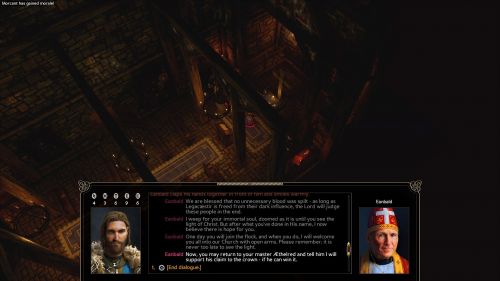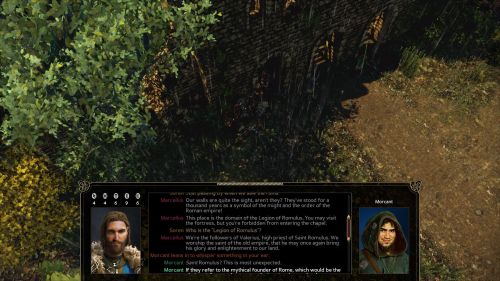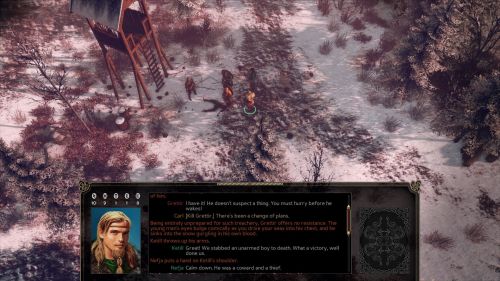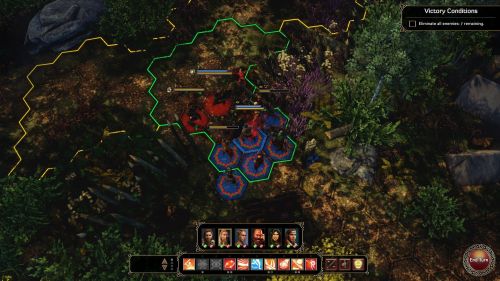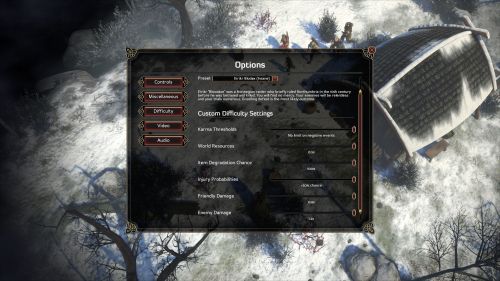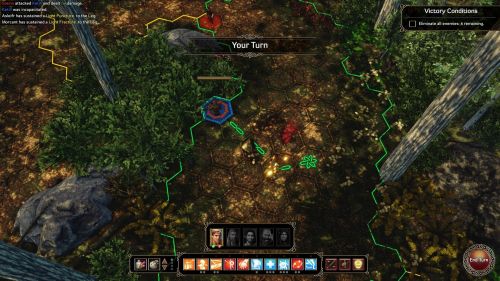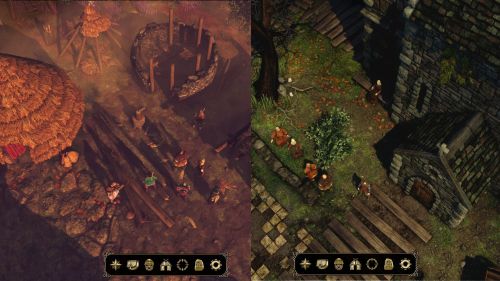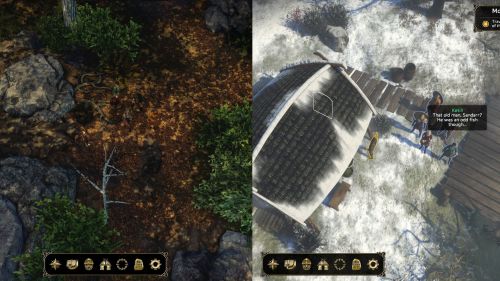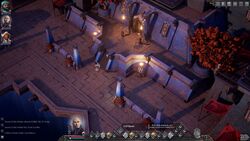RPG Codex Review: Expeditions: Viking
RPG Codex Review: Expeditions: Viking
Codex Review - posted by Infinitron on Fri 19 May 2017, 21:34:00
Tags: Expeditions: Viking; Logic Artists[Review by Tigranes]
Expeditions: Viking – A Review
Expeditions: Viking is the third title from Danish indie outfit Logic Artists. The first, Expeditions: Conquistador, was one of those indie games that found payload in the glory days of CRPG Kickstarters – and, by most accounts, had made good on its promises. It took the awfully underutilised premise of colonial expeditions (and, in general, historical settings) and provided an addictive mix of overworld exploration, resource management, little CYOA sequences, and good old turn-based tactical combat. The sequel, then, comes with fairly high expectations. They had a good thing going, these Danes; could they build on it, and provide something bigger and better? The answer is, in fact, quite complicated.
The Ship of Theseus
It’s complicated because Logic Artists decided to take their tightly enmeshed formula, smash it up into pieces, and make something quite very different. In Conquistador, you cobbled together the often scarce resources; plotted a hazardous trip into the unknown; met ambushes and discovered ancient ruins; arrived in a faraway town to trade wares. In Viking, you run around the city collecting quests, bee-line to your destination, make some choices on quest resolution, and loot thy reward. Although there remain many similarities with Conquistador, Viking is much more of a ‘traditional’ WRPG, running on a diet of carefully written quests to propel the journey. This shift is an ambitious one, clearly aimed at upgrading the series and not churning out basically the same game again and again (e.g. Shadowrun Returns, King’s Bounty). The results are quite thoroughly mixed.
The central regret is that the sense of discovery, scarcity and precarity that made Conquistador so good is almost totally absent in Viking. On the face of it, this seems odd, given how many of the former’s features are retained in the latter. You still camp, using scarce resources, to rejuvenate your men; you still travel the overland map; you still encounter random events where your men might drink from a spoiled well or your ship struggles under a storm. But these features are often disconnected from each other, or poorly balanced, leaving them too close to trivial and negligible. In Conquistador, you knew to journey throughout the day, and to camp at night, or risk problems; you could chart how far you could get today before needing to camp, and the steady decline of resources would instill further dread on whether you could make it to the next town – if you knew where it was, away into the fog of war. In Viking, you can forego camping for days and force-march your men, because ambushes are rare and you never have to travel very far (despite apparently trekking the length of lower Scotland and upper England). The map, in any case, now disallows free-form travel – and functions more or less like the world map in Baldur’s Gate 2, except for the many predesignated ‘camping sites’ that litter the scene. The exploration and discovery pillar of Conquistador, then, is completely gone. There are almost no secrets to discover, resources to be gathered, landscape to be surveyed. Combined with the fact that resources are far, far too plentiful, one begs the question as to what camping is for, anymore.
You can see that this isn’t specifically a problem about camping; not much would change either way if it were to be removed. In Viking, the features that synergised so effectively in Conquistador are left floundering on their own, unable to really add any special value to the player experience. Without scarcity and exploration, camping is just makework (but is retained). Without anything much to discover or survey, overland exploration is pointless (and thus is removed). Even the little mini-events lose their lustre - when you’re running low on supplies and you’re itching to check that treasure chest yonder, you really think about whether you can spare 6 Rations and 3 Herbs on an injured traveler. If you’re stocked up on hundreds of those things and making a quick trip from Northumbria to Cave A, it’s inconsequential. When we try to describe what makes an RPG good, we often pick out specific features; but we soon realise that it is often the combination of design decisions that make them great. Arcanum’s magic/technology tension is reinforced everywhere from the main plot to character development; Fallout’s ‘setting’ or ‘atmosphere’ encompasses everything from the Vault Boy aesthetic to just the right amount of 50’s America references. Conquistador, whether by luck or by design, had a charming combination going for it – a charm which, in Viking, is only found in little nooks and crannies.
I weep for your immortal soul, doomed as it is
The loss of this old formula is not an accident, but a price deliberately paid. For better or for worse, Viking has introduced a new formula to replace the old – and wants to be judged on those merits. As I said, Viking is much closer to a quest/story-driven WRPG, taking place in fully rendered towns – including genre staples like urban robberies, missing villagers and even a few FedEx quests. Given that this is the second game from a small studio, the level of quality and quantity achieved is generally impressive. There are plenty of quests, many of which exhibit a credible degree of choice & consequences by being weaved into the faction-based storyline. The premise is simple: you journey to Britain and suck up to the Picts and/or the Northumbrians – with the typical result that you side with one of them, or fight them both. There is a reasonably robust depiction of the interests and needs of the factions, and then the ways in which a marauding band of Vikings might enter that picture. Your landfall near a quiet English village is greeted by fear, anxiety, and language issues; should miscommunication (or your violent intent) result in a massacre, you’ll have to explain yourself to the Northumbrians soon after. The bishop will constantly preach on about how you are all doomed as heathens to the fires of hell, but admit willingly that even barbarians might be of use in weeding out another heretic cult. Throughout, the looting and pillaging work done by other Vikings – and sometimes, by you – will rouse resentment and suspicion that you’ll have to assuage one way or another. For the most part, Viking ensures that the sensible consequences to the course of events are charted out, though they never approach, say, the complexity of Fallout: New Vegas.
The quests and faction politics are backed up by a setting that puts the historical backdrop to good use – but also has the good sense to refrain from ham-fisted clichés. There are no freedum-lovin’ rough-and-tumble Picts versus the civilised Northumbrians here (which would, in any case, not be particularly historical) – only two powerful fiefdoms that are both wary of foreign interlopers, and yet willing to do business with them where profitable. Priests will describe your faith as barbaric as a matter of course, but you will also find locals that are still wed to pre-Roman paganism, or a regional cult that exhibits a weird syncretism of Roman founding myths and Christian rituals. To be sure, if you’re looking for full fidelity to history, you won’t find it; but I think it was a wise move for the game to avoid, say, roping in well-known people and events from the history books, which would inevitably annoy anyone who knows the period well. The setting remains a backdrop, mostly avoiding egregious historical inaccuracies while leveraging the material for a sensible gameworld.
All this is achieved through writing that, for the most part, knows when to do its job and when to butt out. Just as with Conquistador, this is not a game you primarily play for the intricate writing – and Viking, to its credit, has realised it. That sounds like damning by faint praise, but it is in fact high praise: there is nothing more obnoxious than a bad writer who won’t shut up (digging myself a giant hole here, etc). Dialogue rarely overstays its welcome. Companions are decent, if unspectacular, saying just enough lines to establish their character then getting out of your way. Sure, there is Ketill, the childhood friend whose quest involves finding his parents, and Nefja, who had to leave behind a sick sister to join the expedition; but the melodrama is largely confined to an optional quest or two, without devolving into Biowarian milksoppery. The writing also differentiates reasonably well between the views and beliefs of different characters, rather than each one mouthing the writer’s thoughts: Nefja, the same one so concerned with her family, will happily advise that the kid who helped you was ‘a coward and a thief’, and we might as well stab, behead, and desecrate his corpse to further your goals. The plot as a whole also stays refreshingly grounded, as well. You begin by newly inheriting a clan, whose sovereignty is challenged by a powerful neighbouring Thegn, and you end by proving at the Althing that you have gained enough military clout to protect your claim. There is no preposterously grandious war, Ancient Evil, or mysterious arcane phenomena that has spoiled so many other CRPG narratives.
A final, quick note: one of the unfortunate consequences to adopting the new formula is an asinine looting system. Each area is full of more barrels and crates than there are cliff racers in Morrowind - and it doesn't help that many corpses have poorly drawn interaction zones, leading to pixel-hunting as you try to loot them. This ends up being a very minor affair, however - and I never missed anything while ignoring 90% of all lootable containers, anyway. All in all, Viking does a credible job of refashioning itself. To be sure, it is definitely not a ‘storyfag’ game; its quests and writing don’t hold up to an Arcanum or Torment. But having lost Conquistador’s formula, all this provides an enjoyable, competitive foil for the ‘lead a bunch of mercenaries through battles for glory and loot’ process. It will be up to the player as to which formula sounds more enticing.
Turn-based combat, bitches
And now we come to the combat – the most important aspect of both Conquistador and Viking, given that you spend the bulk of your playing time fighting. Conquistador had a very good turn-based combat system, which mixed in a robust spread of character abilities with an attractive lineup of consumables to offer a properly tactical experience. Shields must be batted away or broken down to damage the wielder; archers can be confounded by use of cover or distractions; trip-rope and caltrops foil the fast-moving flankers. Here, the underlying formula remains the same; players of Conquistador will recognise and enjoy Viking’s combat immediately. And yet. Once again, the changes to the combination of features in and beyond the combat system effects the experience in mixed ways.
Let’s start with the positives. Viking provides a reasonably balanced and diverse set of abilities to customise your band. Dual-wielders, shield users, bow specialists, or healers versed in ‘totally-not-magic-we-swear’ witchcraft all play very differently. (Hell, Christian characters, allied and enemy, have their own pseudomagic tree in 'Benediction' - a nice touch.) There are sensible synergies built in as well: axemen are good for knocking away shields, opening the way for others to strike. A shield-user might knock an enemy down, at which point the knife-wielder can jump in for a deathblow. Spears can distract enemies, disabling their attack of opportunity as your archer flees the melee. Add in consumables, and Viking has enough toys in the basket to support the dozens of battles it has you fight. This comment also extends to the enemies, most of whom are human and share a similar range of equipment and abilities. The one exception, wolves, also feature several distinct characteristics. Viking’s switch to a more scripted RPG model ensures that there are few trash mobs, and the encounter design as a whole adds significant value to the game.
The problem comes when you plug this combat into the game as a whole. By far the biggest, and most inexcusable, failure is the complete lack of any difficulty. The most difficult, ‘Insane’, might as well be called Story Time. Consider that you will often take six men with you into battle, and normally face between five and ten enemies. Most battles give you the initiative, and any halfway competent player can take out between one and three enemies in that first turn. You do the maths. After the half-way point in my playthrough, I realised it was a waste of time to bother with consumables, or indeed half of the abilities and tactics available to me, since I could roflstomp my way through almost every battle. (Ironically, if not for this problem, Viking’s difficulty settings would be worthy of high praise; it provides customisable sliders for everything that it influences.) This nonexistence of challenge sucks a huge amount of fun out of this kind of game. I realised I didn’t even need to camp after days of marching, because even a hungry and sleep-deprived band could easily emerge victorious. This is a huge departure from Conquistador, and by far the worst thing about Viking.
There are a number of reasons that difficulty plunged off a cliff and into the depths of the Earth. The first is the removal of meaningful attrition. Conquistador was not a particularly difficult game, either, but its combination of strategic costs and combat difficulty could provide different kinds of challenges across short- and long-term gameplay. You had to worry that an injured companion will take a while to fully recover, compromising combat efficiency for the next fight – perhaps prompting a frantic retreat back to town on the overworld map. (This prompted a raft of early complaints that the game was 'too difficult' - though Codexers soon found that Conquistador too becomes too easy after a while, prompting Logic Artists to up the difficulty in a later patch. It appears the lesson has not been learned, at all.) In Viking, you have enough resources that most injuries can be healed in the next rest, and the new travel system means you’d be very unlucky to ever be ambushed. I *think* that companions can die, if their injuries become serious enough – but I wouldn’t know, really. In the recently released Battle Brothers, players learn to approach even the last remaining enemy with care, lest a bro pick up an unlucky injury, or even an early death. Each injury makes itself felt immediately, some of them drastically changing how the bro will fight. Lacking any of this, Viking’s injuries wound only the player’s pride – that you let such an easy battle get to any of your men. Without the wider strategic context, fighting in Viking is similar to the deathless, consequenceless immortal warriors of many newer RPGs: you can just conduct endless Polish cavalry charges, because everybody is pretty much good as new afterwards.
The second is the puzzling changes to determining initiative. Most battles, as I said, give you the first turn – meaning *all* your characters may move and attack first. About half of my fights were practically won on this first turn alone. The developers explain that in some cases where it makes sense, the enemy is pre-scripted to go first. I did not find that it makes full sense. At one point, your companion literally yells “it’s a trap” – only for you to go first. At other times, the enemy will attack first, though the combat was no more a surprise to your band than others. This means that in the vast majority of cases, you are getting free kills that cripple the opposition – while in some rare cases, the enemy gets to use the same trick to take you out before you can do anything. While the lack of challenge is a serious problem, it’s equally silly to begin a fight and have all but one of your band be eliminated before you can move, as happened to me once:
You might say, perhaps that happened only because your preparations were poor: you should have been positioned better. Well, that’s the thing: whereas you could position your men and set up traps in Conquistador, the preparation phase has been removed in Viking. This severely detracts from the tactical gameplay, and dilutes the utility of consumables. You are now left hoping that your followers will wander into the battle trigger in a way that your archer isn’t blocking everybody’s way. Sometimes, you can see your enemies up ahead, and approach them from a different angle; but in many cases, the script trigger is specific enough that you can literally walk up to the enemy from behind and not be able to start fighting. Presumably, this is so that players cannot make the battle even easier, and I have no problem with that. As a whole, though, the design decisions on preparation and initiative scream “you have to fight exactly this way because otherwise it will be too easy to abuse” – and then the battle ends up being piss easy anyway.
The final culprit is player progression. Perhaps because of the nonlinearity of the game, where some players might be barred from whole factions and questlines, Viking is extremely generous with skill points – and also forces you to recruit ten companions, enough to cover every single possible noncombat skill twice over. The result is that by around halfway through the game, you’ve already maximised every skill you could want. One of those skills – crafting – adds its own set of problems. Viking features a basic crafting system, where you expend resources – Salvage and Hide – and characters skilled in crafting will produce weapons and armour. The problem, again, is hideous balancing: because resources are so plentiful, and so are skill points, you will quickly find your companions producing equipment far superior to anything you find in the world – and indeed, strong enough to render combat even more trivial.
As an experiment, I decided to undertake a whole second playthrough of the game before writing this review. In contrast to Thegn Soren Kierkegaard, who played the game fairly 'normally', Thegn Carl Linnaeus would always bring one less party member than is permitted to every fight (e.g. 5 not 6); forego crafting altogether; and withhold earned skill points, only spending them several quests after they were gained. The difference was marked. Even accounting for my increased player skill, the hird of Carl finally had battles where I had to pull out consumables and think through different action plans to succeed – and even battles where I was down to my last man, running for cover from the enemy archer. And this is the thing: when challenge returned, the battles became incredibly fun affairs. Viking, like Conquistador, has a very strong combat system, and its range of player abilities and competitive encounter design means it has all the potential to deliver an excellent turn-based combat experience. My criticisms should be taken not to mean that combat is irredeemably rubbish, but as a frustration that a combination of avoidable mistakes holds it back.
Matters of style
Finally, let me touch on production values: art style, sound, UI, polish. As a relatively low-cost small-studio operation, Viking has done well to evoke the period. The Pict settlement of Perth features distinct architecture from Northumbria, the latter also being dominated by the ruined walls from the Roman era. Jutland, in which the player spends the winter, also contrasts markedly with the temperate environments of springtime Britain. In the beginning of the game, Jutland’s snowy areas aren’t particularly flattering; I think most games using top-down or pseudo-isometric angles struggle to get the harsh contrast and colours of snowy areas right, with the obvious exception being Icewind Dale. The visuals really pick up once the player is able to criss-cross the different regions. The music is also surprisingly good – and varied across regions and areas, suggesting a deliberate investment in an area that many games fail to pay much attention to.
Viking, however, did suffer from a raft of bugs upon release, pointing to an inadequate QA process. Quest scripts would get tangled up, or lead to area loading crashes, stalling playthroughs altogether; dual-wielders would hit enemies, allies, and sometimes *themselves*, when they weren’t simply getting confused and hanging the game for a full minute until their move timed out. The degree to which this matters depends on the player; I’ve always been of the belief that a great but buggy game is ultimately a great game, while a shit game is shit regardless. To their credit, Logic Artists appear to have actively patched many of these problems away, with the game about to get its third patch ~3 weeks into release.
Verdict
Is Expeditions: Viking a good game? Yes, yes it is. My criticisms are many, but they address the relatively lofty heights to which the game clearly aspires: a turn-based tactical RPG that somehow merges elements of an exploratory, resource-management strategic layer with a quest/story-driven model. The results are ambiguous, and in many ways, I prefer the tightly woven mechanics of Conquistador. But if you were to ask me whether it is worth the money, I would answer, absolutely: it is a game that provides robust turn-based tactical combat, a competently written historical setting, and plenty of entertaining quests. I dearly hope that the Expeditions series continues – and continues to tinker its formula.
And then I’d add: you should probably play on insane, with less party members. And never craft, jesus christ.
Expeditions: Viking – A Review
Expeditions: Viking is the third title from Danish indie outfit Logic Artists. The first, Expeditions: Conquistador, was one of those indie games that found payload in the glory days of CRPG Kickstarters – and, by most accounts, had made good on its promises. It took the awfully underutilised premise of colonial expeditions (and, in general, historical settings) and provided an addictive mix of overworld exploration, resource management, little CYOA sequences, and good old turn-based tactical combat. The sequel, then, comes with fairly high expectations. They had a good thing going, these Danes; could they build on it, and provide something bigger and better? The answer is, in fact, quite complicated.
The Ship of Theseus
It’s complicated because Logic Artists decided to take their tightly enmeshed formula, smash it up into pieces, and make something quite very different. In Conquistador, you cobbled together the often scarce resources; plotted a hazardous trip into the unknown; met ambushes and discovered ancient ruins; arrived in a faraway town to trade wares. In Viking, you run around the city collecting quests, bee-line to your destination, make some choices on quest resolution, and loot thy reward. Although there remain many similarities with Conquistador, Viking is much more of a ‘traditional’ WRPG, running on a diet of carefully written quests to propel the journey. This shift is an ambitious one, clearly aimed at upgrading the series and not churning out basically the same game again and again (e.g. Shadowrun Returns, King’s Bounty). The results are quite thoroughly mixed.
The central regret is that the sense of discovery, scarcity and precarity that made Conquistador so good is almost totally absent in Viking. On the face of it, this seems odd, given how many of the former’s features are retained in the latter. You still camp, using scarce resources, to rejuvenate your men; you still travel the overland map; you still encounter random events where your men might drink from a spoiled well or your ship struggles under a storm. But these features are often disconnected from each other, or poorly balanced, leaving them too close to trivial and negligible. In Conquistador, you knew to journey throughout the day, and to camp at night, or risk problems; you could chart how far you could get today before needing to camp, and the steady decline of resources would instill further dread on whether you could make it to the next town – if you knew where it was, away into the fog of war. In Viking, you can forego camping for days and force-march your men, because ambushes are rare and you never have to travel very far (despite apparently trekking the length of lower Scotland and upper England). The map, in any case, now disallows free-form travel – and functions more or less like the world map in Baldur’s Gate 2, except for the many predesignated ‘camping sites’ that litter the scene. The exploration and discovery pillar of Conquistador, then, is completely gone. There are almost no secrets to discover, resources to be gathered, landscape to be surveyed. Combined with the fact that resources are far, far too plentiful, one begs the question as to what camping is for, anymore.
You can see that this isn’t specifically a problem about camping; not much would change either way if it were to be removed. In Viking, the features that synergised so effectively in Conquistador are left floundering on their own, unable to really add any special value to the player experience. Without scarcity and exploration, camping is just makework (but is retained). Without anything much to discover or survey, overland exploration is pointless (and thus is removed). Even the little mini-events lose their lustre - when you’re running low on supplies and you’re itching to check that treasure chest yonder, you really think about whether you can spare 6 Rations and 3 Herbs on an injured traveler. If you’re stocked up on hundreds of those things and making a quick trip from Northumbria to Cave A, it’s inconsequential. When we try to describe what makes an RPG good, we often pick out specific features; but we soon realise that it is often the combination of design decisions that make them great. Arcanum’s magic/technology tension is reinforced everywhere from the main plot to character development; Fallout’s ‘setting’ or ‘atmosphere’ encompasses everything from the Vault Boy aesthetic to just the right amount of 50’s America references. Conquistador, whether by luck or by design, had a charming combination going for it – a charm which, in Viking, is only found in little nooks and crannies.
I weep for your immortal soul, doomed as it is
The loss of this old formula is not an accident, but a price deliberately paid. For better or for worse, Viking has introduced a new formula to replace the old – and wants to be judged on those merits. As I said, Viking is much closer to a quest/story-driven WRPG, taking place in fully rendered towns – including genre staples like urban robberies, missing villagers and even a few FedEx quests. Given that this is the second game from a small studio, the level of quality and quantity achieved is generally impressive. There are plenty of quests, many of which exhibit a credible degree of choice & consequences by being weaved into the faction-based storyline. The premise is simple: you journey to Britain and suck up to the Picts and/or the Northumbrians – with the typical result that you side with one of them, or fight them both. There is a reasonably robust depiction of the interests and needs of the factions, and then the ways in which a marauding band of Vikings might enter that picture. Your landfall near a quiet English village is greeted by fear, anxiety, and language issues; should miscommunication (or your violent intent) result in a massacre, you’ll have to explain yourself to the Northumbrians soon after. The bishop will constantly preach on about how you are all doomed as heathens to the fires of hell, but admit willingly that even barbarians might be of use in weeding out another heretic cult. Throughout, the looting and pillaging work done by other Vikings – and sometimes, by you – will rouse resentment and suspicion that you’ll have to assuage one way or another. For the most part, Viking ensures that the sensible consequences to the course of events are charted out, though they never approach, say, the complexity of Fallout: New Vegas.
The quests and faction politics are backed up by a setting that puts the historical backdrop to good use – but also has the good sense to refrain from ham-fisted clichés. There are no freedum-lovin’ rough-and-tumble Picts versus the civilised Northumbrians here (which would, in any case, not be particularly historical) – only two powerful fiefdoms that are both wary of foreign interlopers, and yet willing to do business with them where profitable. Priests will describe your faith as barbaric as a matter of course, but you will also find locals that are still wed to pre-Roman paganism, or a regional cult that exhibits a weird syncretism of Roman founding myths and Christian rituals. To be sure, if you’re looking for full fidelity to history, you won’t find it; but I think it was a wise move for the game to avoid, say, roping in well-known people and events from the history books, which would inevitably annoy anyone who knows the period well. The setting remains a backdrop, mostly avoiding egregious historical inaccuracies while leveraging the material for a sensible gameworld.
All this is achieved through writing that, for the most part, knows when to do its job and when to butt out. Just as with Conquistador, this is not a game you primarily play for the intricate writing – and Viking, to its credit, has realised it. That sounds like damning by faint praise, but it is in fact high praise: there is nothing more obnoxious than a bad writer who won’t shut up (digging myself a giant hole here, etc). Dialogue rarely overstays its welcome. Companions are decent, if unspectacular, saying just enough lines to establish their character then getting out of your way. Sure, there is Ketill, the childhood friend whose quest involves finding his parents, and Nefja, who had to leave behind a sick sister to join the expedition; but the melodrama is largely confined to an optional quest or two, without devolving into Biowarian milksoppery. The writing also differentiates reasonably well between the views and beliefs of different characters, rather than each one mouthing the writer’s thoughts: Nefja, the same one so concerned with her family, will happily advise that the kid who helped you was ‘a coward and a thief’, and we might as well stab, behead, and desecrate his corpse to further your goals. The plot as a whole also stays refreshingly grounded, as well. You begin by newly inheriting a clan, whose sovereignty is challenged by a powerful neighbouring Thegn, and you end by proving at the Althing that you have gained enough military clout to protect your claim. There is no preposterously grandious war, Ancient Evil, or mysterious arcane phenomena that has spoiled so many other CRPG narratives.
A final, quick note: one of the unfortunate consequences to adopting the new formula is an asinine looting system. Each area is full of more barrels and crates than there are cliff racers in Morrowind - and it doesn't help that many corpses have poorly drawn interaction zones, leading to pixel-hunting as you try to loot them. This ends up being a very minor affair, however - and I never missed anything while ignoring 90% of all lootable containers, anyway. All in all, Viking does a credible job of refashioning itself. To be sure, it is definitely not a ‘storyfag’ game; its quests and writing don’t hold up to an Arcanum or Torment. But having lost Conquistador’s formula, all this provides an enjoyable, competitive foil for the ‘lead a bunch of mercenaries through battles for glory and loot’ process. It will be up to the player as to which formula sounds more enticing.
Turn-based combat, bitches
And now we come to the combat – the most important aspect of both Conquistador and Viking, given that you spend the bulk of your playing time fighting. Conquistador had a very good turn-based combat system, which mixed in a robust spread of character abilities with an attractive lineup of consumables to offer a properly tactical experience. Shields must be batted away or broken down to damage the wielder; archers can be confounded by use of cover or distractions; trip-rope and caltrops foil the fast-moving flankers. Here, the underlying formula remains the same; players of Conquistador will recognise and enjoy Viking’s combat immediately. And yet. Once again, the changes to the combination of features in and beyond the combat system effects the experience in mixed ways.
Let’s start with the positives. Viking provides a reasonably balanced and diverse set of abilities to customise your band. Dual-wielders, shield users, bow specialists, or healers versed in ‘totally-not-magic-we-swear’ witchcraft all play very differently. (Hell, Christian characters, allied and enemy, have their own pseudomagic tree in 'Benediction' - a nice touch.) There are sensible synergies built in as well: axemen are good for knocking away shields, opening the way for others to strike. A shield-user might knock an enemy down, at which point the knife-wielder can jump in for a deathblow. Spears can distract enemies, disabling their attack of opportunity as your archer flees the melee. Add in consumables, and Viking has enough toys in the basket to support the dozens of battles it has you fight. This comment also extends to the enemies, most of whom are human and share a similar range of equipment and abilities. The one exception, wolves, also feature several distinct characteristics. Viking’s switch to a more scripted RPG model ensures that there are few trash mobs, and the encounter design as a whole adds significant value to the game.
The problem comes when you plug this combat into the game as a whole. By far the biggest, and most inexcusable, failure is the complete lack of any difficulty. The most difficult, ‘Insane’, might as well be called Story Time. Consider that you will often take six men with you into battle, and normally face between five and ten enemies. Most battles give you the initiative, and any halfway competent player can take out between one and three enemies in that first turn. You do the maths. After the half-way point in my playthrough, I realised it was a waste of time to bother with consumables, or indeed half of the abilities and tactics available to me, since I could roflstomp my way through almost every battle. (Ironically, if not for this problem, Viking’s difficulty settings would be worthy of high praise; it provides customisable sliders for everything that it influences.) This nonexistence of challenge sucks a huge amount of fun out of this kind of game. I realised I didn’t even need to camp after days of marching, because even a hungry and sleep-deprived band could easily emerge victorious. This is a huge departure from Conquistador, and by far the worst thing about Viking.
There are a number of reasons that difficulty plunged off a cliff and into the depths of the Earth. The first is the removal of meaningful attrition. Conquistador was not a particularly difficult game, either, but its combination of strategic costs and combat difficulty could provide different kinds of challenges across short- and long-term gameplay. You had to worry that an injured companion will take a while to fully recover, compromising combat efficiency for the next fight – perhaps prompting a frantic retreat back to town on the overworld map. (This prompted a raft of early complaints that the game was 'too difficult' - though Codexers soon found that Conquistador too becomes too easy after a while, prompting Logic Artists to up the difficulty in a later patch. It appears the lesson has not been learned, at all.) In Viking, you have enough resources that most injuries can be healed in the next rest, and the new travel system means you’d be very unlucky to ever be ambushed. I *think* that companions can die, if their injuries become serious enough – but I wouldn’t know, really. In the recently released Battle Brothers, players learn to approach even the last remaining enemy with care, lest a bro pick up an unlucky injury, or even an early death. Each injury makes itself felt immediately, some of them drastically changing how the bro will fight. Lacking any of this, Viking’s injuries wound only the player’s pride – that you let such an easy battle get to any of your men. Without the wider strategic context, fighting in Viking is similar to the deathless, consequenceless immortal warriors of many newer RPGs: you can just conduct endless Polish cavalry charges, because everybody is pretty much good as new afterwards.
The second is the puzzling changes to determining initiative. Most battles, as I said, give you the first turn – meaning *all* your characters may move and attack first. About half of my fights were practically won on this first turn alone. The developers explain that in some cases where it makes sense, the enemy is pre-scripted to go first. I did not find that it makes full sense. At one point, your companion literally yells “it’s a trap” – only for you to go first. At other times, the enemy will attack first, though the combat was no more a surprise to your band than others. This means that in the vast majority of cases, you are getting free kills that cripple the opposition – while in some rare cases, the enemy gets to use the same trick to take you out before you can do anything. While the lack of challenge is a serious problem, it’s equally silly to begin a fight and have all but one of your band be eliminated before you can move, as happened to me once:
You might say, perhaps that happened only because your preparations were poor: you should have been positioned better. Well, that’s the thing: whereas you could position your men and set up traps in Conquistador, the preparation phase has been removed in Viking. This severely detracts from the tactical gameplay, and dilutes the utility of consumables. You are now left hoping that your followers will wander into the battle trigger in a way that your archer isn’t blocking everybody’s way. Sometimes, you can see your enemies up ahead, and approach them from a different angle; but in many cases, the script trigger is specific enough that you can literally walk up to the enemy from behind and not be able to start fighting. Presumably, this is so that players cannot make the battle even easier, and I have no problem with that. As a whole, though, the design decisions on preparation and initiative scream “you have to fight exactly this way because otherwise it will be too easy to abuse” – and then the battle ends up being piss easy anyway.
The final culprit is player progression. Perhaps because of the nonlinearity of the game, where some players might be barred from whole factions and questlines, Viking is extremely generous with skill points – and also forces you to recruit ten companions, enough to cover every single possible noncombat skill twice over. The result is that by around halfway through the game, you’ve already maximised every skill you could want. One of those skills – crafting – adds its own set of problems. Viking features a basic crafting system, where you expend resources – Salvage and Hide – and characters skilled in crafting will produce weapons and armour. The problem, again, is hideous balancing: because resources are so plentiful, and so are skill points, you will quickly find your companions producing equipment far superior to anything you find in the world – and indeed, strong enough to render combat even more trivial.
As an experiment, I decided to undertake a whole second playthrough of the game before writing this review. In contrast to Thegn Soren Kierkegaard, who played the game fairly 'normally', Thegn Carl Linnaeus would always bring one less party member than is permitted to every fight (e.g. 5 not 6); forego crafting altogether; and withhold earned skill points, only spending them several quests after they were gained. The difference was marked. Even accounting for my increased player skill, the hird of Carl finally had battles where I had to pull out consumables and think through different action plans to succeed – and even battles where I was down to my last man, running for cover from the enemy archer. And this is the thing: when challenge returned, the battles became incredibly fun affairs. Viking, like Conquistador, has a very strong combat system, and its range of player abilities and competitive encounter design means it has all the potential to deliver an excellent turn-based combat experience. My criticisms should be taken not to mean that combat is irredeemably rubbish, but as a frustration that a combination of avoidable mistakes holds it back.
Matters of style
Finally, let me touch on production values: art style, sound, UI, polish. As a relatively low-cost small-studio operation, Viking has done well to evoke the period. The Pict settlement of Perth features distinct architecture from Northumbria, the latter also being dominated by the ruined walls from the Roman era. Jutland, in which the player spends the winter, also contrasts markedly with the temperate environments of springtime Britain. In the beginning of the game, Jutland’s snowy areas aren’t particularly flattering; I think most games using top-down or pseudo-isometric angles struggle to get the harsh contrast and colours of snowy areas right, with the obvious exception being Icewind Dale. The visuals really pick up once the player is able to criss-cross the different regions. The music is also surprisingly good – and varied across regions and areas, suggesting a deliberate investment in an area that many games fail to pay much attention to.
Viking, however, did suffer from a raft of bugs upon release, pointing to an inadequate QA process. Quest scripts would get tangled up, or lead to area loading crashes, stalling playthroughs altogether; dual-wielders would hit enemies, allies, and sometimes *themselves*, when they weren’t simply getting confused and hanging the game for a full minute until their move timed out. The degree to which this matters depends on the player; I’ve always been of the belief that a great but buggy game is ultimately a great game, while a shit game is shit regardless. To their credit, Logic Artists appear to have actively patched many of these problems away, with the game about to get its third patch ~3 weeks into release.
Verdict
Is Expeditions: Viking a good game? Yes, yes it is. My criticisms are many, but they address the relatively lofty heights to which the game clearly aspires: a turn-based tactical RPG that somehow merges elements of an exploratory, resource-management strategic layer with a quest/story-driven model. The results are ambiguous, and in many ways, I prefer the tightly woven mechanics of Conquistador. But if you were to ask me whether it is worth the money, I would answer, absolutely: it is a game that provides robust turn-based tactical combat, a competently written historical setting, and plenty of entertaining quests. I dearly hope that the Expeditions series continues – and continues to tinker its formula.
And then I’d add: you should probably play on insane, with less party members. And never craft, jesus christ.
There are 48 comments on RPG Codex Review: Expeditions: Viking






